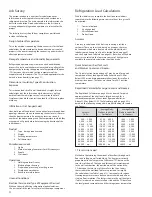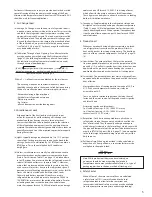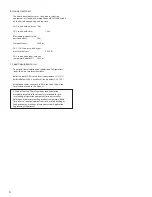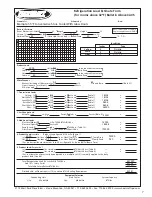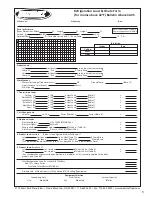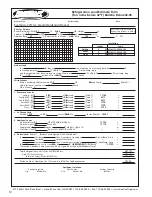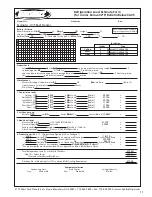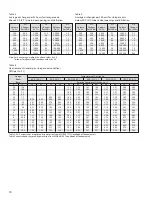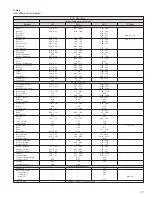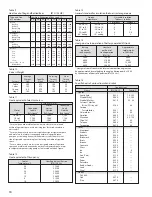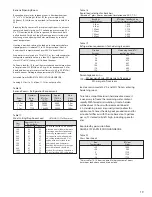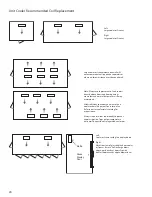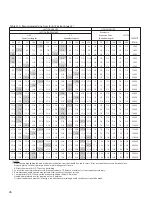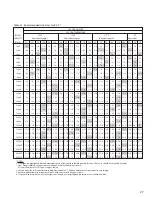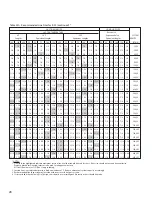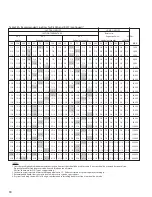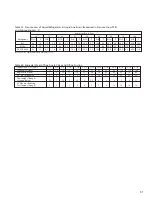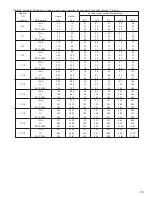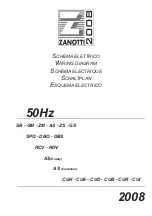
18
Table 9
Heat Loads of Keg and Bottled Beer (BTU / 24 HR)
Type and Size Temperature Reduction of Beer only. ºF.
of Container
60
50
40
30
20
15
10
5
Wood
One Keg
—
— 12000 9000 6000 4500 3000 1500
Half Keg
—
—
5600 4650 3100 2325 1550 775
Quarter Keg
—
—
3200 2400 1600 1200 800
400
Eighth Keg
—
—
1640 1230 820
615
410
205
Aluminum
Half Keg
—
—
5200 3900 2600 1950 1300 650
Quarter Keg
—
—
2560 1920 1280 960
640
320
Eighth Keg
—
—
1400 1050 700
525
350
175
Steel
Half Keg
—
—
4800 3600 2600 1800 1200 600
Quarter Keg
—
—
2400 1800 1200 900
600
300
Bottles
6 oz.
32
27
22
16
10.8
8.1
5.4
2.7
7 oz.
37
31
25
20
124
9.3
6.2
3.1
8 oz.
42
35
28
21
14.0 10.5
7.0
3.5
9 oz.
47
38
30
23
15.2 11.4
76
3.8
12 oz.
60
50
40
30
20
15
10
5.0
Cases of 24 - 12 oz.
Bottles/Cans
1920 1600 1280 960
640
480
320
160
Table 13
General standard for insulation thickness in storage rooms
ºF.
ºC.
Styrofoam
Urethane
-50º to -25º
-45º to -32º
8
6
-25º to -0º
-32º to -18º
6
4
0º to 25º
-18º to -4º
4
4
25º to 40º
-4º to 5º
4
3 - 4
40º and up
+5º and up
2
2
Storage
Desirable Insulation
Temperature
Thickness in Inches
Battery
Heat Gain
Approximate
operated
per hour of
total weight
load capacity
truck operation
of lift truck
lb.
BTU / hr.*
lb.
2,000
14,000
6,000
4,000
21,000
8,000
6,000
23,000
12,000
8,000
26,000
14,000
Table 14
Heat gain due to operation of battery operated lift truck
* Heat gain from lift trucks with internal combustion engines can
be approximated by multiplying the engine horsepower by 2,545
by the number of hours of operation (BTU/24 Hrs.)
Average
Entering
Final
Weight
Specific
Carcass
Carcass
Carcass
lbs.
Heat
Temp. ºF.
Temp. ºF.
Cattle
550
0.77
106
35
Calves
150
0.76
104
35
Sheep
45
0.76
101
33
Hogs
180
0.54
106
35
Table 12
Heat equivalent of Occupancy
BTU per (HP) (HR)
Motor
Connected
Connected
Losses
Load
Motor
Load In
Outside
Outside
HP
Refr Space
1
Refr Space
2
Refr Space
3
1/8 to 1/2
4,250
2,545
1,700
1/2 to 3
3,700
2,545
1,150
3 to 20
2,950
2,545
400
Table 10
Carcass Weight
1
For use when both useful output and motor losses are dissipated
within refrigerator space: motors driving fans for forced circulation
unit coolers.
2
For use when motor losses are dissipated outside refrigerated space
and useful work of motor is expended within refrigerated space:
pump on a circulating brine or chilled water system, fan motor out-
side refrigerated space driving fan circulating air within refrigerated
space.
3
For use when motor heat losses are dissipated within refrigerated
space and useful work expended outside of refrigerated space: motor
in refrigerated space driving pump or fan located outside of space.
Cooler
Heat Equivalent / Person
Temperature ºF.
BTU / 24 Hrs.
50
17,280
40
20,160
30
22,800
20
25,200
10
28,800
0
31,200
-10
33,600
Table 11
Heat equivalent of electric motors
Table 15
Specific heats of various liquids and solids
Liquids
Acetic Acid
0.522
79 - 203
Alcohol-Ethyl
0.680
32 - 208
Alcohol-Methyl
0.610
59 - 68
Calcium Chloride
Brine (20% by wt.)
0.744
68
Carbon
Tetrachloride
0.201
68
Chloroform
0.234
68
Gasoline
0.500
32 - 212
Glycerine
0.575
59 - 120
Olive Oil
0.471
44
Toluene
0.404
68
Turpentine
0.420
68
Solids
Aluminum
0.214
—
Asphalt
0.220
—
Bakelite
0.350
—
Brickwork
0.200
—
Brass
0.090
—
Bronze
0.104
—
Concrete
0.156
—
Glass
0.200
—
Ice
0.465
-4
Ice
0.487
32
Iron (Cast)
0.120
—
Lead
0.031
—
Paper
0.320
—
Porcelain
0.180
—
Rubber Goods
0.480
—
Sand
0.191
—
Steel
0.120
—
Woods
Fir 0.650
—
Oak
0.570
—
Pine
0.670
—
Specific Heat
Name
BTU/lb./ºF.
Temp ºF.

